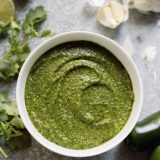In 17th-century Spain, adobo was a way to preserve foods. At Milk Street, it has become a bold, simple way to preserve flavor.
Spanish for marinade, adobo can actually be many things—a sauce, a spice blend, even a dish unto itself. But it began as a blend of oil, vinegar and spices which was slathered over foods to preserve them. The vinegar’s acidity discourages spoiling, and oil slows oxidation.
Instead of applying it to pork or vegetables, we wanted to use adobo’s preservative powers on something more delicate, something that could be smeared on almost anything (see sidebar). We were inspired by a Mexican-style adobo from Rick Bayless, who blends garlic, serrano chilies, cilantro, parsley and oil. The result is a rich sauce that plays up—and preserves for weeks—the flavor of the fresh herbs.
We loved the idea of a fresh herb sauce we could have on hand for nearly a month. But we found Bayless’ recipe packed too much heat to be the all-purpose sauce we wanted. We opted for jalapeno peppers over serrano chilies; the latter can vary widely in heat level from dud to scud. And instead of blackening the peppers on the stovetop, we switched to the broiler, which allowed us to cook the garlic at the same time. This approximates the charring that is common in Mexican kitchens.
We also left out the parsley, going all in on cilantro instead. Its fresh, clean flavor became even bolder when it didn’t need to compete with another herb.
Like many herbs, cilantro is edible from root to flower, so using both leaves and stems not only was easier, it also significantly enhanced the flavor of the sauce. And because it’s blended with oil, the herb sauce can be refrigerated for up to 3 weeks. Fresh cilantro flavor at our fingertips, no mincing required.
- Quesadillas: Smear a thin layer of adobo on tortillas before filling and toasting.
- Beans: Stir into cooked pinto or black beans, either whole or refried, or puree with either variety to spread on tortas or quesadillas.
- Meats: Use as a dipping sauce for roasted or grilled beef or a rich pork shoulder.
- Fish: Thin with additional olive oil, then spoon over seared scallops or roasted salmon or halibut.
- Sweet potatoes: Mix with plain Greek-style yogurt, then drizzle over roasted sweet potato wedges or use as a dip.
- Sandwiches: Stir together equal parts adobo and mayonnaise, then use as a sandwich spread, particularly with turkey, chicken or a BLT.
- Vinaigrettes: Add a spoonful to any neutral-flavored vinaigrette (use citrus, rice vinegar or white balsamic vinegar for the acid).
- Eggs: Fold into barely set scrambled eggs, drizzle over fried eggs or add to egg salad.
- Hummus: Swirl a spoonful into the top of hummus or baba ghanoush.
- Pasta: Add a tablespoon or 2 to cheddar macaroni and cheese or basic marinara sauce.
- Rice: Fold into a pot of cooked rice (about 1 tablespoon per cup of rice); season with plenty of lime juice.




